Arkadi Monastery and its Tragedy
Just a week or so after visiting the Ter Apel cloister, a place of peace and contemplation, I arrived at The Holy Monastery of Arkadi in Crete, a similarly contemplative religious place.

Disclosure: This article contains affiliate links. Making a purchase through an affiliate link will mean a small commission for this website. This will not affect your price. Privacy policy.
Arkadi is Eastern Orthodox, while Ter Apel was Catholic and then Protestant, yet it looked to me as if the monks in both places lived in very similar ways. They spent their time in contemplation or prayer inside a church or walking along covered passages around a courtyard. They lived in ascetic conditions in small, simply-furnished cells.
Though about the same age, give or take a couple of hundred years, the two monasteries look very different. Yet they felt much the same to me; they both had a calming atmosphere. Arkadi, however, is better known for a bloody episode, known as the “Arkadi Tragedy.”
Visiting Arkadi
Arkadi Monastery, founded in the 13th century, is in the inland hills of northern Crete, about 20 minutes by car from the town of Rethymnon. The most important building – the church, called the Katholikon – dates from the 16th century and has a Renaissance façade. Once holding about a hundred monks, three still live there today.
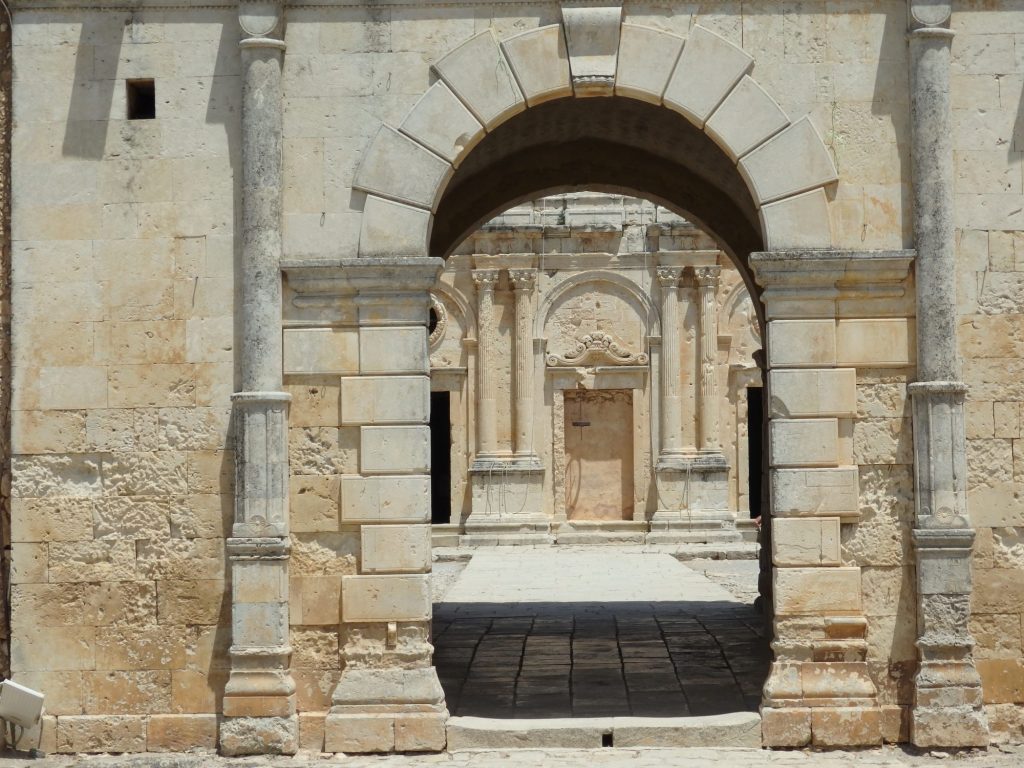
Visitors enter through the west gate in the massive outer building and arrive in a large inner courtyard. Given the climate, this isn’t the kind of green oasis I saw in Ter Apel, yet many potted flowering plants and a scattering of trees still give it a garden feel.
Directly through the gate is the church. I spotted Roman influences in the façade, and liked the pleasing proportions of this double-aisled church. Inside, it was typically Eastern Orthodox, with many icons on the walls, votive candles flickering, and a big open space in the middle.
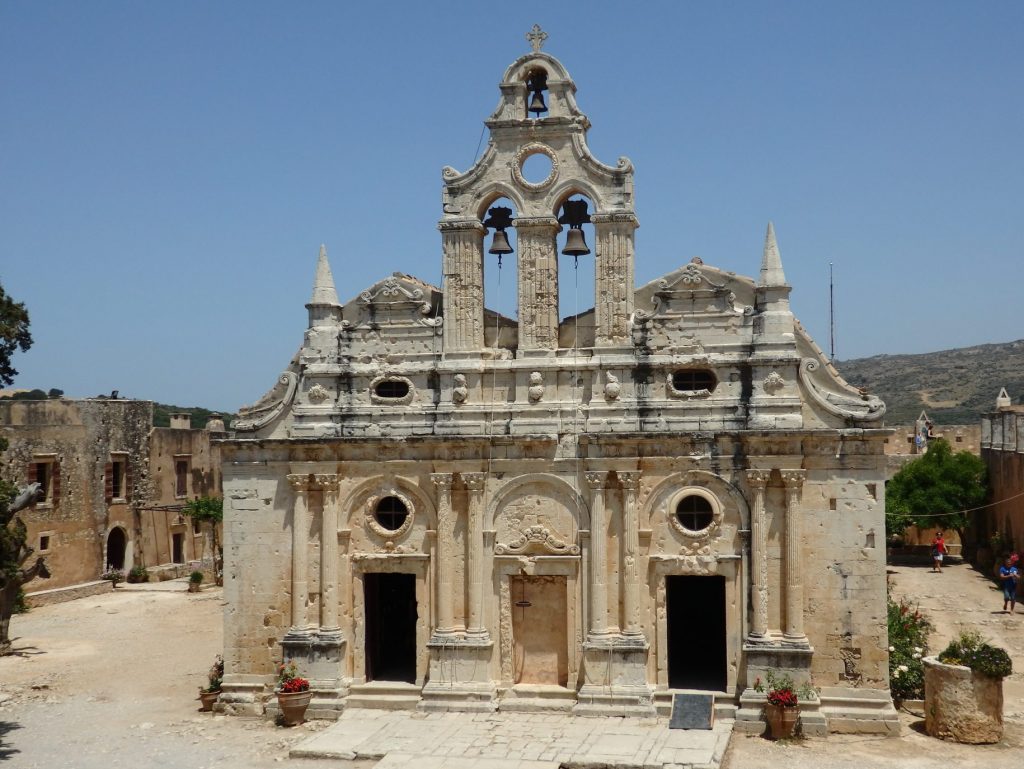
In the building encircling the courtyard are many other rooms to explore. A few simply-furnished former monks’ cells show how they lived, as does the refectory. In the basement, besides a gift shop where you can buy an icon to take home, you can see where the monks gave food and shelter to visiting pilgrims and the poor.
Here are more articles about destinations in Crete:
And if you’ll be passing through Athens, read this one: 20 interesting facts about the Acropolis.
The Arkadi Tragedy
In the 17th century, the Turks conquered Crete. They ransacked the monastery, but then allowed it to continue to be used as a monastery for the next 200 years. In 1866, the monks at the monastery took part in the Cretan rebellion against the Turks, who threatened to destroy the monastery.
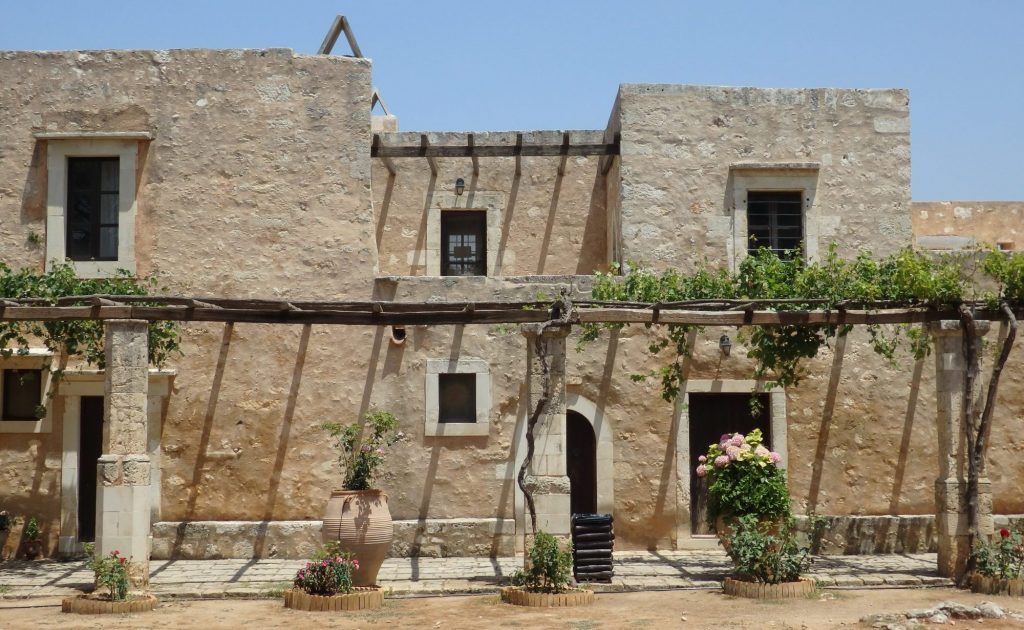
According to Wikipedia, the monastery contained 964 people, including 259 armed men. The women and children had taken refuge there, hoping for protection from the Turks.
15,000 Turkish troops arrived and demanded the surrender of the monastery, which the Cretans inside refused. A battle ensued, lasting till the next day, with heavy losses on both sides.
The women and children hid in the powder room, where the Cretans stored their gunpowder. When the Turks arrived at the door to the powder room, a Cretan fighter named Konstantinos Giaboudakis set the powder alight, leading to an explosion which killed hundreds of women and children, as well as the Turks and Cretans inside and outside the room.
The Arkadi martyrs today
Today, Cretans revere those who died at Arkadi for their sacrifice and patriotism. Photos of some of the Cretan fighters hang in several rooms of the monastery: a “permanent exhibit gallery for warriors of the Cretan race,” according to the sign at the entrance. The powder room remains roofless, with an artwork in its one intact end depicting the crowds packed into the space.
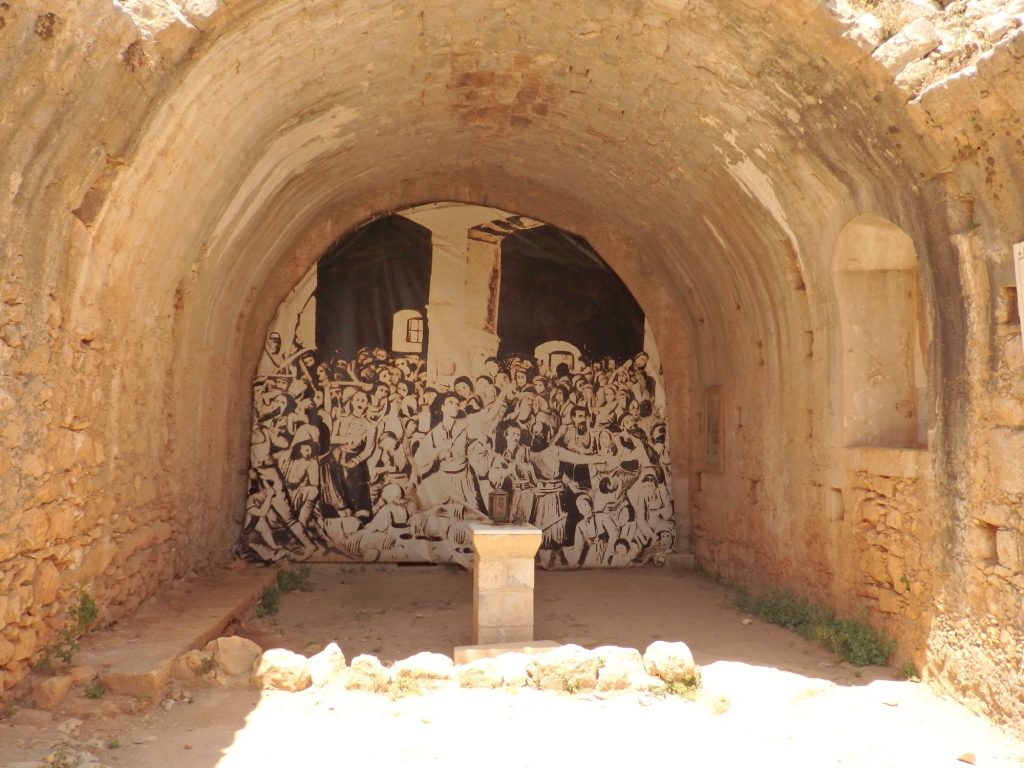
While I admire the Cretans’ bravery and dedication to their cause, this story raises questions for me. Was this really their only option? Apparently they believed that the Turks would take their women and children into slavery, and perhaps that was so. I don’t know.
I particularly would like to know if Giaboudakis at least consulted the women hiding in the powder room. Did they agree to die rather than be captured? Did they agree that killing their children would be better than surrendering to the Turks? Or did Giaboudakis just carry out the ultimate patriarchal decision, assuming that he could speak for everyone by blowing up the gunpowder room?
The story reminds me of Masada in Israel, another example of a rebel group choosing to die rather than be taken captive. In the case of Masada, it was the Roman army they were resisting, and, when all hope was lost, they collectively committed suicide. There, too, I wondered if anyone consulted the women before making such a final decision.
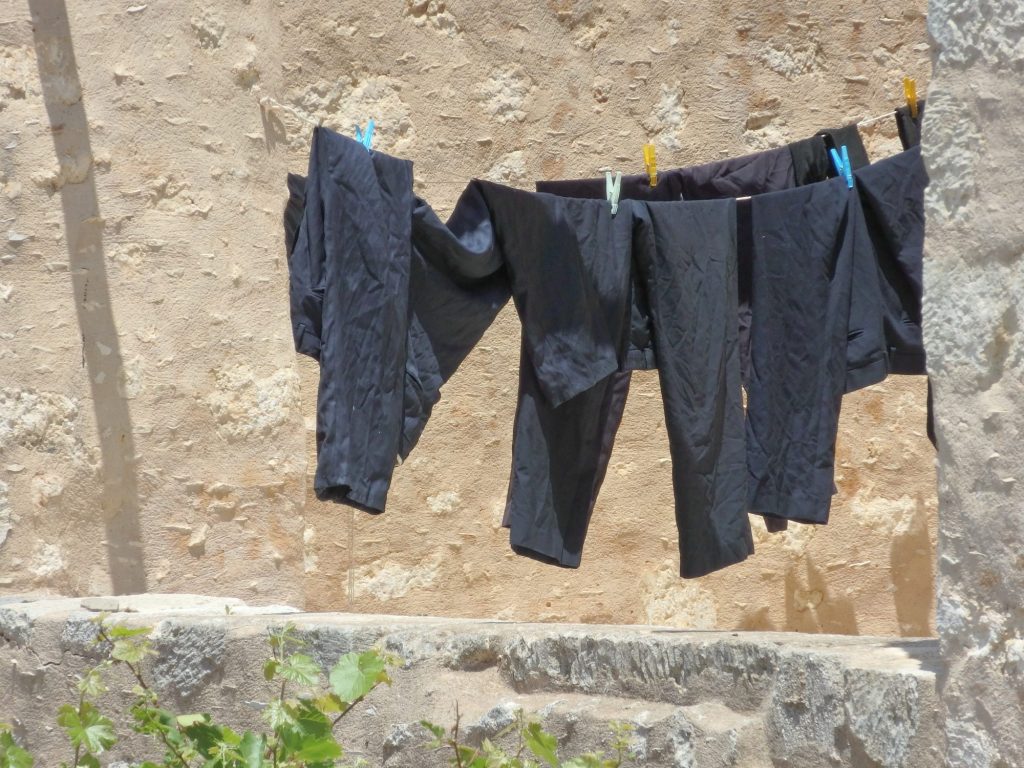
It’s odd how a place where such horrible violence occurred can now seem so peaceful. Masada felt that way too, when I arrived there in time to see the sunrise. It seems as if the sacrificial deaths that occurred at Arkadi make it, for lack of a better word, holy.
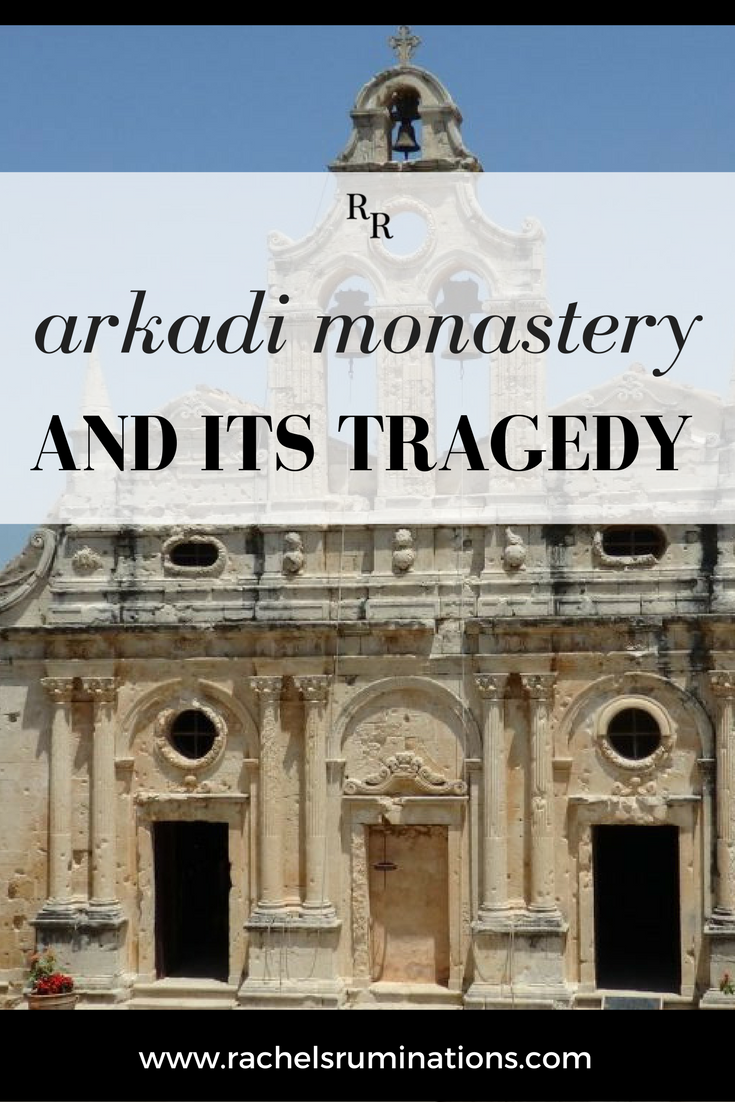
Suggestions for your visit to Crete
If you’re planning some island-hopping, or you need to get to Crete from Athens, book your ferry ride ahead of time, especially in the busy tourist season. The same goes for your rental car, which is probably the easiest way to get around the island, and also for accommodations. Use the map below to choose accommodations; it’s centered on Arkadi Monastery, so zoom out to see the whole island.
My travel recommendations
Planning travel
- Skyscanner is where I always start my flight searches.
- Booking.com is the company I use most for finding accommodations. If you prefer, Expedia offers more or less the same.
- Discover Cars offers an easy way to compare prices from all of the major car-rental companies in one place.
- Use Viator or GetYourGuide to find walking tours, day tours, airport pickups, city cards, tickets and whatever else you need at your destination.
- Bookmundi is great when you’re looking for a longer tour of a few days to a few weeks, private or with a group, pretty much anywhere in the world. Lots of different tour companies list their tours here, so you can comparison shop.
- GetTransfer is the place to book your airport-to-hotel transfers (and vice-versa). It’s so reassuring to have this all set up and paid for ahead of time, rather than having to make decisions after a long, tiring flight!
- Buy a GoCity Pass when you’re planning to do a lot of sightseeing on a city trip. It can save you a lot on admissions to museums and other attractions in big cities like New York and Amsterdam.
- Ferryhopper is a convenient way to book ferries ahead of time. They cover ferry bookings in 33 different countries at last count.
Other travel-related items
- It’s really awkward to have to rely on WIFI when you travel overseas. I’ve tried several e-sim cards, and GigSky’s e-sim was the one that was easiest to activate and use. You buy it through their app and activate it when you need it. Use the code RACHEL10 to get a 10% discount!
- Another option I just recently tried for the first time is a portable wifi modem by WifiCandy. It supports up to 8 devices and you just carry it along in your pocket or bag! If you’re traveling with a family or group, it might end up cheaper to use than an e-sim. Use the code RACHELSRUMINATIONS for a 10% discount.
- I’m a fan of SCOTTeVEST’s jackets and vests because when I wear one, I don’t have to carry a handbag. I feel like all my stuff is safer when I travel because it’s in inside pockets close to my body.
- I use ExpressVPN on my phone and laptop when I travel. It keeps me safe from hackers when I use public or hotel wifi.



Interesting history of Arkadi Monastery in Crete. As I live in Greece, I gradually hear more and more stories of how this country suffered at the hands of the Turks through the centuries – it’s shocking.
Yes, it was not a history I knew much about, but I sensed that the resentment still remains.
A terrible piece of history – I’m glad that Arkadi has returned to its former peaceful existence. I’m intrigued by the fact that only three monks live there now; that must make it a rather lonely place.
Yes, it must be. Though I suppose that would make it that much more conducive to contemplation. I think it’s a problem all religious orders deal with: an aging population and very few young people feeling called to religious life.
A great tour and glimpse into yet another area impacted by the Turkish/Greek conflicts.
Thanks, Jackie!
Very good questions, Rachel, as I’ve wondered also who makes the decision of “…Liberty or death…” in a mass suicide. And of course, there are always those zealots all too willing to make the grand gesture for those without a voice in the decision. Arkadi Monastery is indeed a very lovely place with maybe a few ghosts of its own…
Maybe that’s why it seems such a quiet place… it’s got ghosts! Yes, people admire that kind of zeal, but I wonder if I could ever feel strongly enough to do such a thing…
Wow, what a powerful and interesting history. Thank you for sharing it. I love history!!
Me too! Nothing better than poking around a good ruin or historical building!
It’s wonderful to see that Crete has restored this important place, and that you felt the power of Arkadi when you visited. Special places like this stay with us forever.
Indeed!
I suggest that you do some more research and for sure after you don’t question anything anymore. The Turks were true barbarians and they killing and torture techniques that a normal human being would never even think about. Eveybody would choose a death by their own hands than to fall in the hands of a Turk. Back then if you got taken by the Turks the only way to get lucky was to give them lots of money. This way your head would be cut off immediately. If you didn’t had this luck they could cut off your bodyparts one by one and make you die slowly with icredible pain. They made new houses with people inside the wall. If you would open the wall this day,you would find human bones inside it. Can you imagine? Have you heard about daskalogiannis and what they did to him? Tell me after if you would rather kill yourself or give yourself to the Turks
I did not make a judgement on whether this was a good or bad decision. What I did say was that I wondered whether the women were even consulted or the decision was just made for them.
Important context. Thankyou.
Before putting such questions out there, please go in depth in your research. The Genocide that the Greeks went through with the Turks (all over Greece and Asia Minor) is not told in history classes and not widely known. They mutilated young boys and I won’t even go into detail as to what they did to the women and young girls. Also, what I have read when researching this Monastery is that it was a game plan they had from the beginning. That is why they were in the gun powder room.
As I replied to an earlier comment, I did not make any judgement on this event, whether it was a good or bad decision or who was at fault. What I did say was that I wondered whether the women were consulted or whether the decision was just made for them by the men. Are you saying that the women decided this, not the men? That they decided to go into the powder room with their kids and blow themselves up?